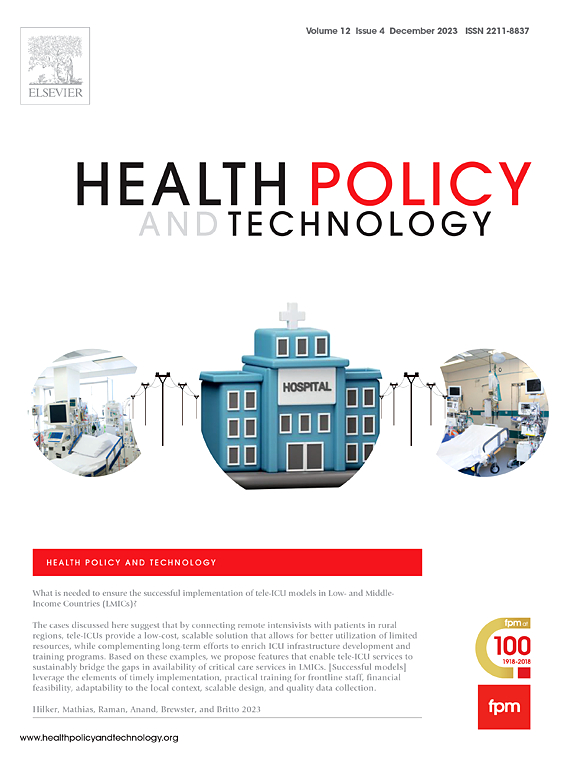Mexico city monitoring system during the COVID-19 pandemic: A case-study
IF 3.7
3区 医学
Q1 HEALTH POLICY & SERVICES
引用次数: 0
Abstract
Objective
Robust monitoring systems are essential for resilient health systems and effective crisis management. This study examines the design and implementation of a health monitoring system during the early months of the COVID-19 pandemic in Mexico City, highlighting lessons for future crises.
Methods
Using a descriptive case study approach, we triangulated official documents, press conference reviews, and 13 hour interviews with key informants.
Results
At the onset of the pandemic, the Mexico City government established a Health Council, necessitating a system to provide reliable information for hospital capacity management and timely decision-making. The locally developed monitoring system centralized data from multiple sources, estimated and forecasted key indicators, and served as a foundation for communicating pandemic status and guiding policy. The system’s dashboard became a critical tool for intersectoral collaboration to reduce hospital burden and improve decision-making —facilitating coordination among government ministries, non-health sectors, and the general population.
Conclusions
The implementation of Mexico City’s monitoring system demonstrates how a shared framework can incentivize intersectoral collaboration and provides critical insights for strengthening preparedness and resilience in future emergencies. Key lessons for fostering intersectoral collaboration included the importance of strong leadership within a governance structure, consensus on emergency assessment tools, provision of actionable information, and adaptability to partner capacities.
Lay summary
During the COVID-19 pandemic, Mexico City developed a health monitoring system that helped manage hospital capacity and coordinate decisions across different government sectors. This system provided reliable and timely information, making it easier for authorities to act quickly and effectively. The research shows how working together—health authorities, commerce groups, and others—can lead to better outcomes in a crisis. It also highlights the importance of clear communication and transparency. These lessons can help cities be better prepared for future health emergencies, ultimately protecting the wellbeing of the public.
2019冠状病毒病大流行期间墨西哥城监测系统:案例研究
目的健全的监测系统对于具有复原力的卫生系统和有效的危机管理至关重要。本研究考察了墨西哥城在2019冠状病毒病大流行的最初几个月里健康监测系统的设计和实施情况,强调了为未来危机提供的经验教训。方法采用描述性案例研究方法,我们对官方文件、新闻发布会评论和对关键线人的13小时采访进行了三角分析。结果大流行发生时,墨西哥城政府成立了卫生委员会,需要一个系统来为医院容量管理和及时决策提供可靠的信息。当地开发的监测系统集中了多个来源的数据,对关键指标进行了估计和预测,并为通报疫情状况和指导政策奠定了基础。该系统的仪表板成为部门间协作的关键工具,以减轻医院负担并改善决策——促进政府部门、非卫生部门和一般人群之间的协调。墨西哥城监测系统的实施表明,共享框架可以激励部门间合作,并为加强对未来紧急情况的准备和复原力提供重要见解。促进部门间协作的关键经验包括:在治理结构中必须有强有力的领导、就紧急情况评估工具达成共识、提供可操作的信息以及对伙伴能力的适应能力。在2019冠状病毒病大流行期间,墨西哥城开发了一个卫生监测系统,帮助管理医院容量并协调不同政府部门的决策。该系统提供了可靠和及时的信息,使当局更容易迅速有效地采取行动。这项研究表明,卫生当局、商业团体和其他各方如何共同努力,才能在危机中取得更好的结果。它还强调了明确沟通和透明度的重要性。这些经验可以帮助城市更好地为未来的突发卫生事件做好准备,最终保护公众的福祉。
本文章由计算机程序翻译,如有差异,请以英文原文为准。
求助全文
约1分钟内获得全文
求助全文
来源期刊

Health Policy and Technology
Medicine-Health Policy
CiteScore
9.20
自引率
3.30%
发文量
78
审稿时长
88 days
期刊介绍:
Health Policy and Technology (HPT), is the official journal of the Fellowship of Postgraduate Medicine (FPM), a cross-disciplinary journal, which focuses on past, present and future health policy and the role of technology in clinical and non-clinical national and international health environments.
HPT provides a further excellent way for the FPM to continue to make important national and international contributions to development of policy and practice within medicine and related disciplines. The aim of HPT is to publish relevant, timely and accessible articles and commentaries to support policy-makers, health professionals, health technology providers, patient groups and academia interested in health policy and technology.
Topics covered by HPT will include:
- Health technology, including drug discovery, diagnostics, medicines, devices, therapeutic delivery and eHealth systems
- Cross-national comparisons on health policy using evidence-based approaches
- National studies on health policy to determine the outcomes of technology-driven initiatives
- Cross-border eHealth including health tourism
- The digital divide in mobility, access and affordability of healthcare
- Health technology assessment (HTA) methods and tools for evaluating the effectiveness of clinical and non-clinical health technologies
- Health and eHealth indicators and benchmarks (measure/metrics) for understanding the adoption and diffusion of health technologies
- Health and eHealth models and frameworks to support policy-makers and other stakeholders in decision-making
- Stakeholder engagement with health technologies (clinical and patient/citizen buy-in)
- Regulation and health economics
 求助内容:
求助内容: 应助结果提醒方式:
应助结果提醒方式:


